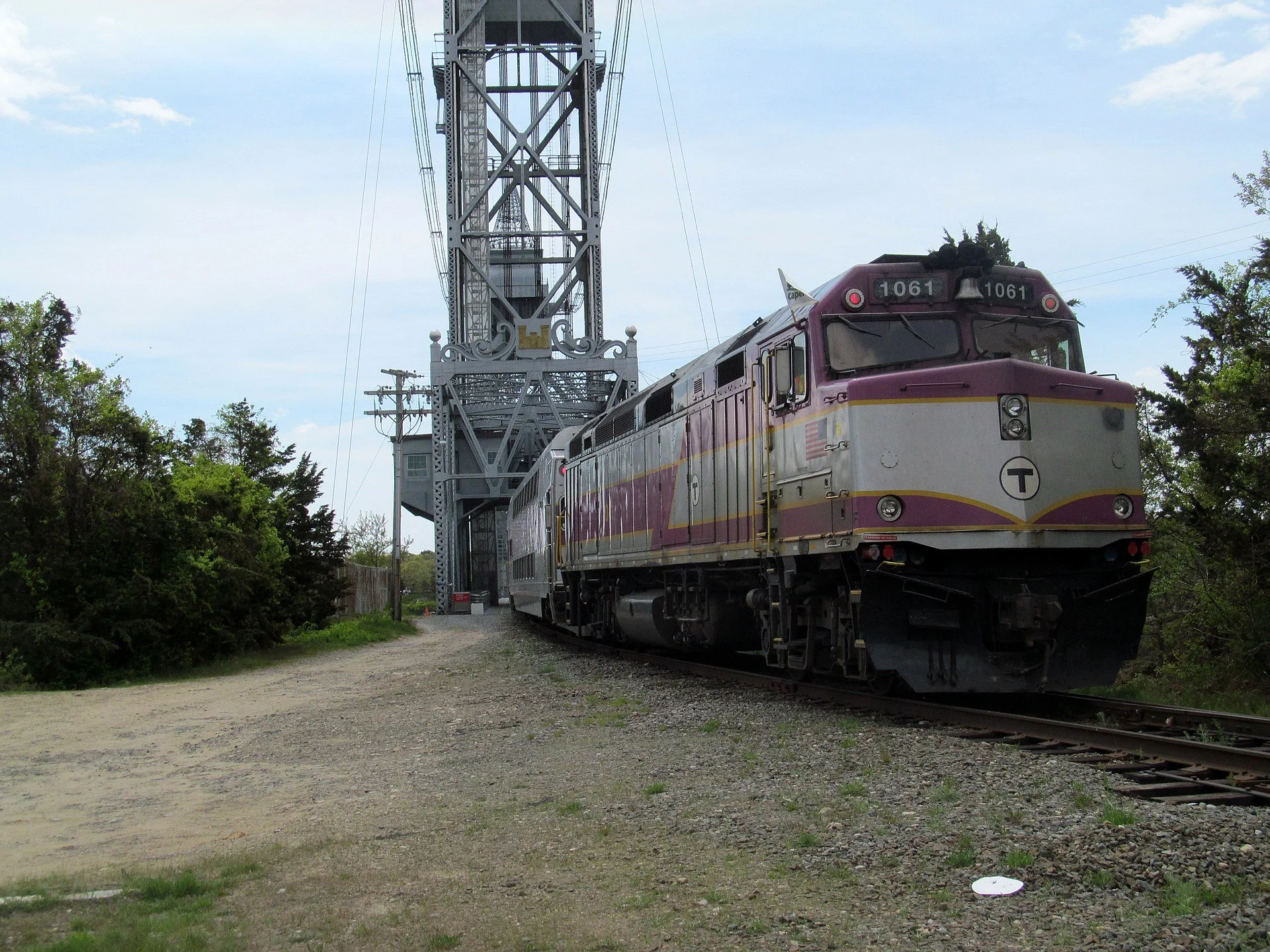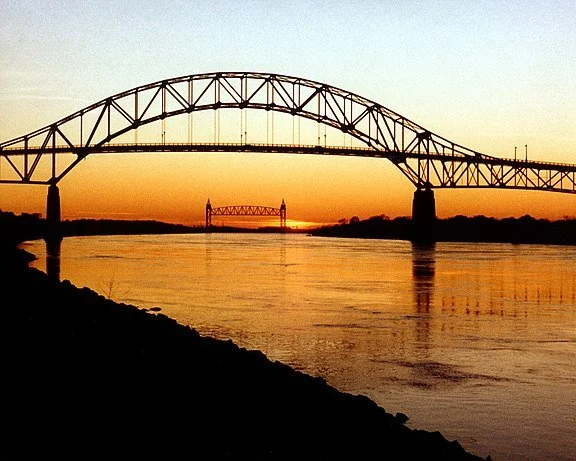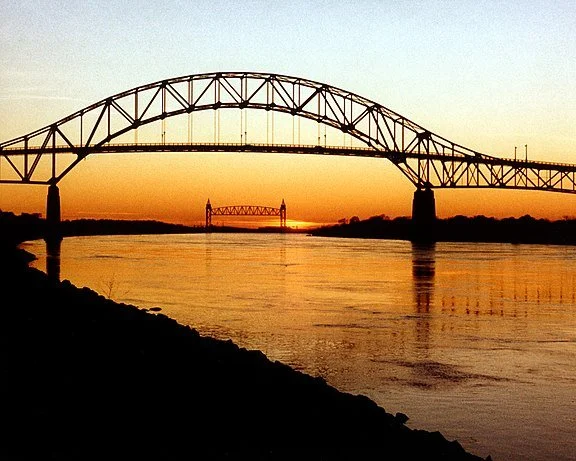
Bridge bathos and beauty
Cape Cod Canal Railroad Bridge, in foreground, and Bourne Bridge in December 1935 after soon after they were completed. The Sagamore Bridge is out of sight here.
Adapted from Robert Whitcomb’s “Digital Diary,’’ in GoLocal24.com
Most readers have driven on the two vehicle bridges – the Sagamore and Bourne -- over the spectacular Cape Cod Canal and noticed that the Feds built them both in only two years – 1933-1935 – with equipment and building materials inferior to what we have now. The current bridges have been impressively sturdy, though driving on the two-way spans, with their too-narrow lanes, can be unnerving. Clench your teeth and look straight ahead!
There’s also the Cape Cod Canal Railroad Bridge, also built in 1933-1935, allowing a bit of freight and seasonal passenger service on the Cape.
So the decision has been made to replace the bridges, via a combination of federal and state money. Officials say that construction of the new Sagamore Bridge won’t start until 2027 and building of a new Bourne Bridge until 2029. The hope is to complete the Sagamore Bridge by 2034 and the Bourne Bridge maybe by 2036. The total cost is projected to be $4.5 billion.
(Who of us old folks will be around to see the new bridges, and would we be too decrepit to drive on them? Would the new bridges make things, worse, not better, traffic-wise, by drawing even more people to the Cape?)
It’s very difficult to do big projects in America because of too many sometimes conflicting jurisdictions, too many permitting layers and the sometimes paralyzing fear of litigation. It would be nice if officials used the new bridges as a nation-leading example of how to speed up big projects.
I also thought of how more railroad service to the Cape would help cut down on what is often from May to October’s horrific car traffic going to and from what is a man-made island.
Likewise, Aquidneck Island would be more habitable if a railroad(s) – MBTA and/or Amtrak -- connected it with the outside world and took a lot of vehicles off the road. New bridges would, of course, be needed. The terminus would be at Thames Street in Newport, whence tourists could easily walk to many of the City by the Sea’s famous sights and sites. Alas, that’s more billions of bucks!
‘It would be energizing and uplifting if the new bridges we do put up in such watery places as Rhode Island and Massachusetts were more than just for vehicles. They could be lively attractions, providing dramatic views for pedestrians and bicyclists. There could be plantings on them and maybe even snack bars. They could become like public squares, albeit with anti-suicide fences….
A CapeFLYER train, providing seasonal service, crosses the Cape Cod Canal Railroad Bridge on the Cape Main Line in 2013.
— Photo by Pi.1415926535
Rescue the Cape by rail
The Bourne Bridge, over the Cape Cod Canal, with the Cape Cod Canal Railroad Bridge in the distance. The Bourne Bridge mostly serves drivers coming from the west.
The Sagamore Bridge, which mostly serves drivers coming from the north, especially from Greater Boston
— Photo by Matt H. Wade.
Adapted from Robert Whitcomb’s “Digital Diary,’’ in GoLocal24.com
The narrow Bourne and Sagamore bridges, the only ways to drive to and from Cape Cod, were built back in the ‘30s and need to be replaced; they’re approaching being dangerous to drive on. Massachusetts Department of Transportation experts like the idea of replacing them with two sets of twin bridges. From an engineering standpoint, that sounds like a good idea. Let’s hope that adequate federal funds will be made available to do this.
But it’s unlikely that the new bridges would reduce traffic congestion on the Cape itself. Indeed, they could increase it by “smoothing” traffic over the canal, thus sending more drivers onto the skinny peninsula’s Route 6 (one long parking lot on summer weekends) and Route 28, some of whose traffic goes to ferry service to Martha’s Vineyard and Nantucket. (We generally stay away from the Cape from Memorial Day to after Labor Day, though we have a few relatives there.)
What would help save what’s left of the fragile, overbuilt, now mostly suburban Cape Cod is much more passenger rail service as an alternative to driving, including train stations close to the most popular summer places.
Let’s hope that whatever replacement spans go up are beautiful, befitting the spectacular setting of the world’s widest sea-level canal, with its dramatic bluffs.
Third Cape Cod Canal road bridge too much
The Bourne Bridge and the Cape Cod Canal Railroad Bridge
From Robert Whitcomb’s “Digital Diary,’’ in GoLocal24.com
’m glad that the Army Corps of Engineers decided against proposing a third bridge over the Cape Cod Canal, though some folks in the tourist trade liked the idea. The already overdeveloped and fragile Cape doesn’t need more cars funneled onto the long, narrow (and washing away) glacial moraine.
The corps does propose replacing the deteriorating Bourne and Sagamore bridges, which were built in the ‘30s. The new bridges would include four travel lanes, two added lanes for merging traffic, and – praise be to God! -- a median separating the on-Cape and off-Cape-bound traffic on each bridge. The lack of a median has added a certain frisson to driving over the New Deal era spans, especially as tank-like SUV’s, which always seem to be speeding, plow across.
Also encouraging is that there will be improved access for bike riders and pedestrians to enjoy the dramatic views of the world’s largest sea-level canal, with steep, wooded bluffs plunging down to it. The current structures would remain in service until the new bridges open to traffic.
The Cape needs more rail service (including railroad stations) as an alternative to cars. So I’m glad the quaint, vertical-lift railroad bridge, also put up in the ‘30s, at the western end of the canal, is not being torn down; it’s said to be in good condition.






